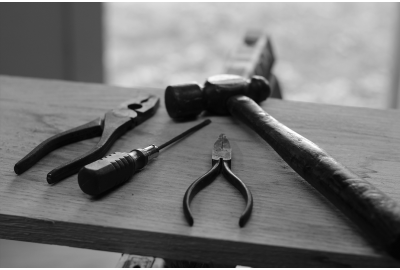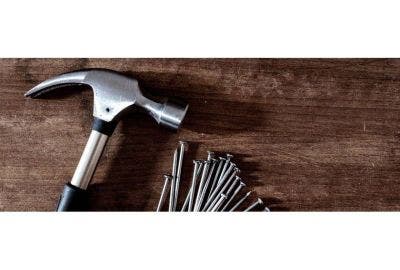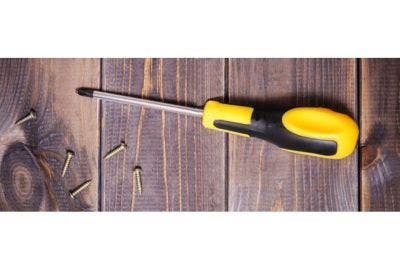Hand tools have been a huge part of human progress since ancient times.
From stone tools to the sophisticated equipment of today, these have helped people to build, create, and innovate.
The need to choose the right product cannot be overstated, as the quality and appropriateness of these directly impact the outcome of any project.
Whether you're a DIY enthusiast, an amateur craftsman, or a professional tradesperson, having the right tools can make a significant difference in efficiency, safety and the overall quality of your work.
This hand tool guide aims to provide detailed insights into selecting, using and maintaining hand tools.
With a focus on quality and practicality, it will help you understand the various types available, the materials and construction that contribute to their durability, and the key features to look for when making a purchase.
Types of Hand Tools
Cutting Tools
These allow you to shape, trim, and divide materials with precision.
Common types of cutting these include saws, knives, and scissors, each serving unique purposes.
- Saws: Saws come in various types, such as hand saws, hacksaws and coping saws. Hand saws are ideal for cutting wood, hacksaws are used for metal, and coping saws are perfect for intricate cuts in wood and plastic.
- Knives: Utility knives and craft knives are versatile and suitable for a wide range of materials, including cardboard, plastic and thin wood. They are particularly useful for detailed and precise work.
- Scissors: Heavy-duty scissors and shears are designed to cut through tough materials like fabric, leather, and metal sheets. They offer the leverage needed for thicker materials.
Selecting the right cutting tool depends on the specific task at hand. For example, choose a hand saw for rough woodcutting and a coping saw for detailed work.
Frequent maintenance can keep these effective. Regularly sharpen blades, clean off any residue and store them properly to avoid damage.
Measuring Tools
Different types of measuring include tape measures, rulers, and callipers, each serving specific measurement needs.
- Tape Measures: Ideal for measuring longer distances, tape measures are flexible and can easily fit into tool belts. They come in various lengths, typically ranging from 3 meters to 30 meters.
- Rulers: Rulers are perfect for shorter measurements and straight lines. Metal rulers offer durability and precision, while plastic rulers are lightweight and portable.
- Callipers: Used for more precise measurements, callipers can measure the distance between two opposite sides of an object. They are essential for tasks requiring exact measurements, such as machining and metalworking.
Choosing the appropriate measuring tool depends on the project's requirements. For long distances, use a tape measure; for precise, small measurements, use callipers. Proper care and calibration help maintain the accuracy of measuring tools. Clean them regularly and store them in a safe place to prevent damage.
Fastening Tools
These are necessary for joining materials together securely. Common examples of this include screwdrivers, wrenches, and pliers.
- Screwdrivers: Screwdrivers come in various types, including flathead, Phillips and Torx. Each type fits a specific screw head, providing a secure fit and preventing damage to the screw.
- Wrenches: Wrenches, including adjustable and socket wrenches, are used for tightening or loosening nuts and bolts. They provide the necessary torque to achieve a secure connection.
- Pliers: Pliers are tools used for gripping, bending and cutting wire. Needle-nose pliers, slip-joint pliers and locking pliers each serve different purposes, from delicate work to heavy-duty tasks.
When selecting fastening tools, consider the specific task and the type of fastener involved.
Regular maintenance, such as cleaning and lubrication, helps prolong the life of this equipment and keeps it functioning correctly when needed.
Striking Tools
- Hammers: Hammers come in different types, including claw hammers, ball-peen hammers and sledge hammers. Claw hammers are used for driving nails and removing them, ball-peen hammers are suitable for metalwork and sledgehammers deliver heavy blows.
- Mallets: Mallets, typically made of wood or rubber, are used to apply force without damaging the workpiece. They are perfect for woodworking and assembling delicate materials.
Choosing the right striking tool depends on the job's requirements. A claw hammer is ideal for general carpentry, while a sledgehammer is needed for demolition work.
Safety and maintenance are needed for striking tools. Always wear safety goggles and gloves, and inspect them regularly for damage or wear.
Holding and Clamping Tools
These are for securing materials in place while you work.
Common appliances in this category include clamps, vices, and pliers.
- Clamps: Clamps, such as C-clamps and bar clamps, hold materials firmly in place. They come in various sizes and designs, suitable for different applications.
- Vices: Vises are used to secure an object to a workbench, providing a stable platform for working. Bench vices and pipe vices are common types.
- Pliers: Pliers, including locking pliers and adjustable pliers, offer a secure grip on materials, making them useful for holding, twisting, and turning tasks.
Selecting the right holding or clamping tool depends on the size and type of material.
For example, use a bar clamp for large woodworking projects and a bench vice for metalwork.
Proper care, such as cleaning and lubrication, helps them remain functional and effective.
Materials and Construction
Different materials offer unique benefits and drawbacks, impacting the tool’s durability, weight, and ease of use.
Understanding these aspects allows you to choose products that match your specific needs and work conditions.
By considering the materials and construction methods used in hand tools, you can make sure they will provide reliable service for years to come.
Materials Used in Hand Tools
The materials and construction methods used in hand tools are critical factors that determine their performance, durability, and overall suitability for specific tasks. A solid understanding of these elements is essential for selecting tools that will not only meet your immediate needs but also provide reliable service over time.
Steel is the most prevalent material in hand tools due to its remarkable strength, durability, and resistance to wear.
High-carbon steel is particularly valued for its hardness and ability to maintain a sharp edge, making it an excellent choice for cutting tools like knives and saws. However, high-carbon steel is prone to rust if not properly maintained, necessitating regular cleaning and oiling.
Alloy steel, on the other hand, incorporates elements such as chromium, vanadium and molybdenum to enhance toughness and resistance to corrosion. This makes alloy steel tools ideal for tasks that involve heavy use or exposure to harsh conditions, though they can be heavier and more expensive than tools made from other materials.
Plastic is commonly used in tool handles and other non-load-bearing parts because of its lightweight nature and resistance to moisture. High-quality plastics, such as fibreglass-reinforced nylon, provide a good balance of strength and comfort, making them ideal for tools that require frequent handling.
However, plastic lacks the durability of metal and can become brittle over time, especially when exposed to extreme temperatures.
Wood remains a traditional material for tool handles, offering a comfortable grip and excellent shock absorption. Hardwood species like hickory and ash are often used due to their strength and resilience. While wooden handles are particularly favoured in striking tools like hammers and mallets, they require regular maintenance to prevent moisture damage, which can lead to swelling, cracking, or splintering.
The construction quality of hand tools is equally important. Tools can be either forged or cast, with each method having its own advantages. Forging, which involves shaping metal under high pressure, aligns the metal’s grain structure, resulting in a stronger and more durable tool.
Forged tools are typically more resistant to impact and stress, making them ideal for heavy-duty applications. However, they are generally more expensive and heavier than cast tools. Casting, which involves pouring molten metal into a mould, is a less expensive and quicker process, but it can produce tools that are less robust and more prone to breakage under heavy use.
In addition to the materials and construction methods, the quality of a tool’s joints and connections plays a significant role in its durability. High-quality tools feature robust joints, such as welded or bolted connections, which are less likely to fail under stress. Tools with glued or riveted joints may not hold up as well over time, particularly under heavy use.
Finally, the finish and coating applied to a tool can significantly enhance its resistance to rust, wear, and corrosion. A polished or powder-coated finish not only improves durability but also makes the tool easier to clean, contributing to a longer lifespan.
Key Features to Look for in Hand Tools
Durability
Durability is required when selecting hand tools, as it determines their lifespan and reliability.
These are made from high-quality materials and are designed to withstand heavy use without breaking or wearing out quickly.
Look for products made from high-carbon steel or alloy steel, which offer superior strength and resistance to wear.
Additionally, look for solid construction, such as forged rather than cast, which tends to last longer.
Brands known for their durable products include Stanley, DeWalt, and Bosch, which are renowned for their quality and performance.
Ergonomics
Ergonomically designed tools are needed for user comfort and to prevent long-term injuries, particularly during extended use. Tools that are crafted with ergonomics in mind are designed to fit the natural contours of your hand, reducing the strain and fatigue that can accumulate over time.
Key features to look for in ergonomic tools include comfortable, cushioned grips that prevent blisters and calluses, balanced weight distribution that minimises the effort needed to handle the tool, and anti-vibration handles that absorb shocks and reduce the stress on your hands and wrists.
Using ergonomically designed tools can significantly improve productivity by allowing you to work longer and more comfortably. Moreover, they help reduce the risk of developing repetitive strain injuries (RSIs) such as carpal tunnel syndrome, which can be caused by prolonged use of poorly designed tools.
It’s important to physically test tools whenever possible to make sure they fit comfortably in your hand and provide a secure, non-slip grip that allows for precise control. Leading brands like Irwin and Milwaukee are known for their commitment to ergonomic design, offering tools that combine comfort with efficiency, making them a smart investment for both DIY enthusiasts and professionals.
Versatility
Versatility in hand tools is a key factor to consider when building a toolkit, especially for those who need to handle a variety of tasks with minimal equipment. Multipurpose tools are designed to perform multiple functions, reducing the need for numerous single-function tools and thus saving space, time, and money.
For instance, multi-tools that combine knives, screwdrivers, pliers, and other functions into a single compact device are invaluable for both quick fixes and more complex projects.
Adjustable wrenches and combination pliers are other examples of versatile tools that can adapt to different tasks, making them essential additions to any toolkit. When assessing a tool's versatility, consider not just the number of functions it can perform, but also how effectively it can replace other tools without compromising on performance.
Versatile tools are particularly beneficial for DIY enthusiasts and professionals alike, as they allow you to tackle a wide range of projects with fewer items in your toolkit, increasing your efficiency and reducing the clutter in your workspace.
Safety Features
Safety is required when working with hand tools and selecting tools with built-in safety features can significantly reduce the risk of accidents and injuries. Non-slip grips are one of the most important safety features to look for, as they provide a secure hold even in wet, oily or otherwise slippery conditions. This feature is required for maintaining control over the tool, which helps prevent accidental slips that could lead to injury.
Safety locks are another major feature, particularly for tools with sharp blades or moving parts. These locks that the tool remains securely closed when not in use, preventing accidental cuts or punctures.
Additionally, protective guards are essential for tools like saws and knives, as they shield the user from sharp edges and moving parts, reducing the likelihood of injury.
Investing in tools with these safety features not only protects you but also contributes to a safer working environment overall.
Maintenance and Care for Hand Tools
Proper maintenance and care of your hand tools are essential to ensure their longevity, performance, and safety. Regular upkeep not only extends the life of your tools but also that they function effectively every time you need them.
- Start by cleaning your tools after each use.
- Dirt, debris, and moisture can accumulate on the surfaces, leading to rust and corrosion, particularly on metal parts.
- For cutting tools like saws and knives, regular sharpening is needed to maintain their effectiveness.
- Using a sharpening stone or file can help keep the blades sharp, making your work easier and more precise.
- Lubrication is another vital aspect of tool maintenance. Tools with moving parts, such as pliers and wrenches, should be regularly oiled to prevent rust and ensure smooth operation.
- Apply a few drops of oil to the joints and moving parts, wiping off any excess to avoid attracting dirt.
Proper storage is also key to maintaining your tools. Store them in a dry, clean place, preferably in a tool box or on a pegboard, to protect them from damage. Avoid leaving tools exposed to the elements, as this can accelerate wear and corrosion.
Additionally, regular inspections for signs of wear or damage are necessary. If a tool is damaged or worn, consider repairing or replacing it to maintain safety and functionality.
By following these maintenance guidelines, you can keep your hand tools in top condition, meaning they are always ready for your next project.
Safety Tips for Using Hand Tools
Using hand tools safely is needed to avoid injuries and maintain a productive work environment.
Always wear appropriate personal protective equipment (PPE), such as gloves, safety goggles, and sturdy footwear, to protect yourself from potential hazards.
Before use, inspect your equipment for any damage, as using damaged products can be dangerous.
It is advised to use each tool for its intended purpose and to follow the manufacturer's instructions to prevent accidents.
Additionally, keeping your work area clean and well-lit reduces the risk of accidents by providing a safer working environment.
Choosing the right-hand tools is required for the success of your projects, whether you’re a DIY enthusiast, an amateur craftsman, or a professional tradesperson. Quality tools enhance efficiency, safety, and the overall quality of your work. By understanding the different types of tools, their materials, and key features, you can make informed decisions that suit your needs.
Regular maintenance and a focus on durability, ergonomics, and safety will ensure your tools last and perform well over time. As your skills and projects grow, investing in the right tools becomes even more important. Use this guide to build a toolkit that meets your current needs and adapts to future challenges. For further advice, don’t hesitate to contact us.























